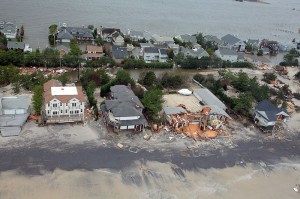
Members of Congress Press the Issue of Adaptation
In a letter sent on February 11th of this year, Democratic members of Congress urged President Obama to create a bipartisan blue ribbon panel that would create a “comprehensive program to help local communities prepare for the anticipated impacts of an increase in climate-related extreme weather events.” This could help address climate change, which the U.S. Global Change Research Group describes in their 2013 National Climate Assessment report as “difficult to prioritize” because each community has different needs and priorities in the planning process. The letter also acknowledges that climate change is already affecting American communities.
We need to find a way to adapt to the increasing prevalence of hurricanes, droughts, and floods.
Scientists are predicting that the frequency of these natural disasters will only increase as time goes on and while we cannot prevent them from happening, we can do something to protect our communities from future disasters.
This letter also points out that in the past two years alone, these natural disasters have cost up to $180 billion in economic damages and caused 1,113 fatalities.
The forty members of Congress who signed this letter have offered five recommendations they believe this blue ribbon panel should execute:
- Determine federal expenditures on disaster relief and recovery from the past five years, and then break down expenditures by individual disaster.
- Determine the cost of building programs that would allow for communities to develop and implement plans that would increase their resilience to natural disasters.
- Identify federal programs already in place that would fund resilience efforts.
- Recommend a revenue stream for communities for pre-disaster planning.
- Create eligibility criteria for communities that would need this revenue stream.
Some officials are already taking steps to protect their communities against future disasters. Governor Andrew Cuomo of New York for example is attempting to buy out homes in disaster prone areas. He is proposing to set aside $400 million to buy residents’ homes at pre-disaster prices. While the buyouts would be voluntary, if for example the residents of a block that is deemed “high risk” decide to leave, the program would give those individuals a 10% bonus. Homeowners who decide to relocate within the same county would get a 5% bonus.
Many neighborhoods that have been hit with numerous storms are willing to accept this program, admitting that residents have been “beaten up” and “do not have the fight to stay anymore” . Residents in areas like Oakwood Beach, Staten Island, which has been hit with routine flooding and brush fires, said they would take up a program like this if offered to them.
In another example, New Jersey Governor Chris Christie has mentioned the idea of buying out residents’ homes however; he says the state will focus more on rebuilding efforts and
marketing campaigns for the Jersey Shore.
If people choose not to move now the damages will only continue. Storms are going to get fiercer, sea levels are going to rise, and flooding is going to become more frequent.
If the new program is passed, the homes in “high risk areas” would then be demolished and some turned into dunes or wetlands. This land would be used as a buffer zone to protect communities against future storms. These properties would not be built on again, leaving fewer people in harm’s way and allowing the government to spend less on recovery efforts.
The EPA is also taking steps to create a plan to adapt to climate change. The first of its kind, this new protection plan calls for mainstreaming climate change into policies to prepare for future climatic conditions. The goal of the EPA is to continue its mission of protecting human health and the environment, and it considers adapting to climate change a key component of that mission.
The EPA, Governor Cuomo, and certain members of Congress are beginning to push the issue of adaptation in earnest. Although climate change has already damaged the natural world and American infrastructure, certain measures such as the five recommendations outlined above and Governor Cuomo’s buyout program offer the chance of combating the effects of climate change before it’s too late.






